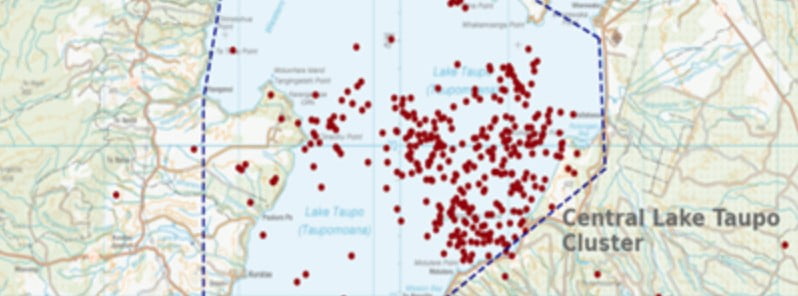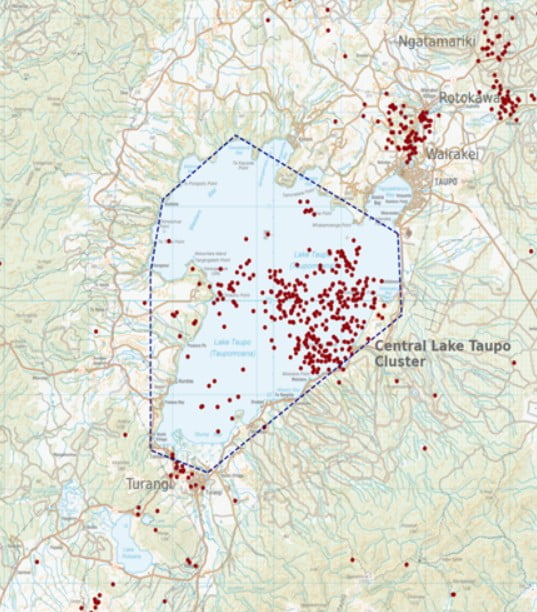Increase in earthquake activity under Lake Taupō, New Zealand

GeoNet is reporting an increase in earthquake activity under Lake Taupō since May 2022. Lake Taupō is a large caldera volcano, a special type of volcano that has rare but unusually large eruptions.
- While Lake Taupō sits above the Taupō volcano, the recent earthquakes are not considered to be an indicator that an eruption is on the way, GeoNet scientists said.
- This activity is similar to recent periods of elevated earthquakes activity and ground deformation measured in 2008-2009 and 2019.
- The Volcanic Alert Level for Taupō Volcanic Centre remains at Level 0.
In 2022, five clusters have been active, beneath the central part of Lake Taupō, north of the lake at Wairakei, Rotokawa, and Ngatamariki, and at Tūrangi.1
The clusters at Wairakei, Rotokawa, and Ngatamariki are generally interpreted as being related to geothermal power development, and the cluster at Tūrangi is probably caused by typical fault movement.
It is the cluster beneath the central part of Lake Taupō, that overlies the Taupō volcano, that has seen an increase in activity since May 2022.
Earthquake activity like this is very typical globally and has been common in the Lake Taupō area, occurring every few years.
This earthquake activity is similar to recent earthquake episodes in 2008-2009 and 2019 under Lake Taupō. Further back, Lake Taupō has seen swarms and earthquake episodes with many more, and larger, earthquakes that have persisted for much longer.
The most active periods of earthquakes occurred in 1895, 1922, 1964-65, and 1983-84.

“Earthquake swarms are very common in the Rotorua-Taupō area and larger ones will last weeks to months and include many hundreds of earthquakes,” said GeoNet Duty Volcanologist Agnes Mazot.
“The area under Lake Taupō (both inside and outside of the caldera) has been seismically active since 2000, with just over 5 000 earthquakes located by our instruments. Since the start of May 2022, we have located over 300 earthquakes, mostly beneath the central part of the lake. The earthquakes have been clustered in small groups in various locations.
“The earthquakes this year have ranged in size from about magnitude 1.0 up to 3.6, while 90% of the depths ranged between 4 and 14 km [2.5 – 8.7 miles] below the surface. The largest earthquake in the sequence has been too small to cause any damage, but almost 300 people living in the area reported feeling it.”
Geological summary
Taupo, the most active rhyolitic volcano of the Taupo volcanic zone, is a large, roughly 35 km (21 miles) wide caldera with poorly defined margins. It is a type example of an “inverse volcano” that slopes inward towards the most recent vent location.
The caldera, now filled by Lake Taupo, largely formed as a result of the voluminous eruption of the Oruanui Tephra about 22 600 years before present (BP).
This was the largest known eruption at Taupo, producing about 1 170 km3 (281 mi3) of tephra. This eruption was preceded during the late Pleistocene by the eruption of a large number of rhyolitic lava domes north of Lake Taupo.
Large explosive eruptions have occurred frequently during the Holocene from many vents within Lake Taupo and near its margins.
The most recent major eruption took place about 1 800 years BP from at least three vents along a NE-SW-trending fissure centered on the Horomotangi Reefs. This extremely violent eruption was New Zealand’s largest during the Holocene and produced the thin but widespread phreatoplinian Taupo Ignimbrite, which covered 20 000 km2 (7 722 mi2) of North Island.2
References:
1 Earthquake activity under Lake Taupō picks up. Volcanic Alert Level remains at Level 0 – GeoNet – July 27, 2022
2 Taupo – Geological summary – GVP
Featured image credit: GeoNet

Commenting rules and guidelines
We value the thoughts and opinions of our readers and welcome healthy discussions on our website. In order to maintain a respectful and positive community, we ask that all commenters follow these rules.